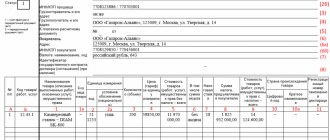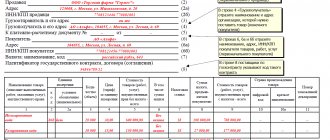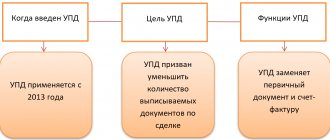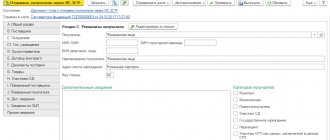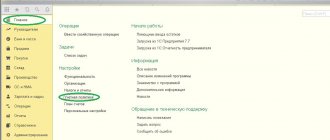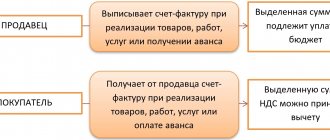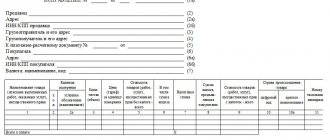Consignment note or act – when and what document to issue?
When processing transactions related to the shipment of goods, works, services, the seller is obliged to issue supporting primary documents.
What kind of documents could these be? To process the shipment, we first remember the following documents:
- Consignment note - used when shipping products of own production or goods intended for resale. Business entities can use the form of the unified form TORG-12, approved by Decree of the State Statistics Committee dated December 25, 1998 No. 132. They also have the opportunity to develop their own form based on it, but with the entry of all mandatory details (Article 9 of the Law “On Accounting” dated 06.12 .2011 No. 402-FZ, hereinafter referred to as Law No. 402-FZ).
- The act of acceptance and transfer of fixed assets is used when selling property. There is also a unified form in Resolution No. 7 of the State Statistics Committee dated January 21, 2003, but you can develop your own.
- Certificate of completed work/rendered services - drawn up when performing work/rendering services. There is no unified form; each organization or individual entrepreneur has the right to develop a form based on its own needs.
- Other forms of documents - these can be acts of acceptance and transfer of property rights, invoices for the release of materials to the party in the form M-15, etc.
If the organization operates in a general mode, the set of shipping documents must also include an invoice. We'll talk about its purpose in the next section.
Why was UPD invented?
One of the main problems in accounting is the abundance of documents.
Papers of varying degrees of importance and necessity fill the accountant’s workspace. In order to lighten the workflow a little and reduce the amount of paper used, a universal document was created that contains several documents
Let’s imagine that we apply the general tax regime and install equipment on the customer’s vehicles. You need to complete 4 documents:
- waybill for equipment + invoice for it;
- certificate for work performed + invoice for it.
The introduction of UPD into the document flow made it possible to replace 4 documents with one - the UPD itself.
IMPORTANT!
UPD combines the functions of a primary document (for example, a waybill, act, etc.) and an invoice.
Please note that the use of UPD is not an obligation, but a right of an economic entity. If you wish, you can print or send electronically two or four documents
But why?!
What is the purpose of a shipping invoice?
An invoice is the primary tax accounting document for VAT. Organizations and individual entrepreneurs are required to submit this document on the OSN, highlighting in it the amount of tax to be paid to the budget for this operation.
Business entities that have received tax exemption under Art. 145 of the Tax Code of the Russian Federation.
In turn, special regime officers, for example, persons using the simplified tax system, may refuse to issue invoices, except in cases where they carry out intermediary or import operations.
The buyer on the OSN requires a correct invoice with all the details in order to accept VAT for deduction. Therefore, sellers should approach the issuance of this document with the utmost care. Its form was approved by Government Decree No. 1137 dated December 26, 2011. Economic entities do not have the right to develop any of their own forms on the basis of this, otherwise the buyer will not be able to accept VAT for deduction, and this is precisely the main purpose of the invoice (Art. 169 of the Tax Code of the Russian Federation).
ATTENTION! As of January 1, 2019, a new invoice form is in effect. Find out more from the material.
However, there is a document to replace the invoice - a universal transfer document. We'll talk about it in the next section.
Is it necessary to use the UPD in an organization?
But primary securities play the following role when determining the tax on profits received:
- Tax benefit - systematization of information for calculating the tax base for contributions to the state budget based on information contained in primary documents (Tax Code of the Russian Federation, Art. 313).
- Incurred expenses are expenses that have documentary evidence drawn up in accordance with the requirements of the legislation of the Russian Federation or papers drawn up in accordance with business norms used in another state within which these expenses took place, and (or) documents in some way confirming the fact of these expenses ( Tax Code of the Russian Federation, Article 252).
The document can be used together with primary standard papers and, accordingly, with invoices. You can use such paper when completing the following types of transactions:
- when transferring existing rights to certain property;
- when providing the results of the activities performed;
- as a result of providing various services.
- when unloading delivered products;
The invoice and delivery note can be replaced with a universal transfer document
In other words, taxpayers can refuse the UTD and, as before, fill out a separate invoice and a separate invoice or report. For companies and entrepreneurs who decide to switch to a universal transfer document, two options are possible. The first option implies that the UPD replaces both the invoice and the invoice or act.
In this case, the universal transfer document simultaneously serves for calculations for and for recognition of expenses for.
Such a document is assigned status 1, which must be indicated in a specially designated field (it is located in the upper left corner of the form). A regular invoice is not needed for the first option.
At the moment, UPD with status 1 cannot be transmitted electronically.
Should a waybill be drawn up when providing cargo transportation services if the counterparty (carrier) issues a universal transfer document (UTD)?
If the UPD does not contain the indicators established as mandatory exclusively for the invoice, this document is used only as a primary document for documenting the facts of economic life, including confirmation of the provision of services.
2 tbsp. 785 of the Civil Code of the Russian Federation).
Can UPD be issued for transport services?
In this case, the reflection in the UPD of the simultaneous shipment of goods and the acceptance and transfer of related services will not violate the requirements of current legislation.
In this case, the document must be signed by representatives of the parties, both authorized to sign invoices and authorized to formalize the fact of economic life, expressed in the transfer of goods with the preliminary provision of related service(s), as well as persons whose competence includes signing legally significant documents on acceptance and transfer of services provided (consumed).
Change the layout from the list of available commands, opened by clicking the More button; save the UPD in the appropriate folder in the selected format using the button or the Save command from the list of available commands, opened by clicking the More button; send the UPD by email using the button or using the Send command from the list of available commands, opened by clicking the More button.
Universal transfer document - what is it?
UPD is a kind of hybrid of a transfer document and an invoice. When completing a trade transaction, the seller can issue not two documents, but only one, which will contain the features of both:
- The invoice details in the UPD are surrounded by a black frame. This part (the presence and sequence of lines, columns and other details) must correspond to the form approved by the Government of the Russian Federation for the invoice. That is, when changes are made to the form, the last part of the UPD highlighted in a frame must also change in accordance with the new requirements.
- The part of the UPD outside the black frame can be changed and supplemented according to the needs of the document compiler - such modifications are not prohibited by law.
The UPD as a whole is intended to replace the set of transfer document (invoice, acceptance certificate, certificate of completion of work) with an invoice - then it has the status “1”.
Also, the UPD can only replace the transfer document - then it has the status “2”, and the invoice is issued separately.
The UPD form is not mandatory for use. It was recommended by the Federal Tax Service in 2013 in order to simplify document flow.
ConsultantPlus experts explained how to correctly fill out the UTD and how to take the document into account in tax accounting. If you don't have access to the system, get a free trial online.
We will describe below how controllers feel about the use of a set of consignment note and invoice and UPD separately.
Which economic entities can use UPD
UTD can be used by any business entity. The contract with the counterparty stipulates the fact of provision of UPD for goods supplied/services rendered/work performed. Using the UPD is not an obligation; you can do it at your own discretion. Moreover, with some counterparties you can use UPD, and with others - invoices/acts and invoices.
As you know, simplifiers are not VAT payers, so they do not issue invoices. If the simplifier issues an invoice with allocated VAT:
- he will have to pay VAT to the budget;
- submit a VAT return only in electronic form;
- will not be able to deduct VAT amounts issued by suppliers.
And, nevertheless, a simplifier can set the UPD and not receive such consequences. How to do it? For such cases, statuses 1 and 2 are provided in the UPD.
We are preparing the implementation: is it possible to issue a UPD instead of TORG-12 and an invoice?
In order to formalize ongoing trade transactions using UTD, organizations/individual entrepreneurs must consolidate this point in the accounting policy (AP).
All forms of documents used in business and not included in the albums of unified forms must be recorded in the UP in order to avoid conflict situations.
By registering a transaction with a universal transfer document, an economic entity does not violate the requirements of legislative norms, since, according to Art. 9 of Law No. 402-FZ, he has the right to independently determine the forms of documenting the facts of economic life - tax officials speak about this in a letter dated October 21, 2013 No. MMV-20-3 / [email protected]
In accounting programs, when registering shipments, you often need to write out both documents - a waybill, for example, in the TORG-12 form, and an invoice, and when choosing a printed form, take advantage of the opportunity to print one document (UPD) instead of two. When performing work or providing services, a set of invoices and deeds can also be replaced by a universal transfer document, but in practice this is quite rare.
Several advantages of using UPD
- The use of universal transfer documents significantly reduces document flow. UTD can be used for several purposes: VAT, income tax and accounting.
- A single style for documents of all types of sales (TORG-12, M-15, acts No. OS-1 and No. OS-1b, TTN).
- Reducing time for processing and checking documents. There is no need to prepare a large package of accounting documentation; it is enough to fill out one general document.
- Reduce the risks associated with discrepancies between the delivery note and the invoice.
- Reducing costs for exchange (transfer), storage and accounting of primary documents.
In conclusion, we can say with confidence: UPD is a worthy alternative to a whole range of accounting documentation drawn up by counterparties. But to use it in your activities or not - the choice is up to each of you.
Results
So, in the article we:
- talked about the forms of primary shipping documents and why an invoice should or should not be included with them;
- found out why the UPD appeared and what distinguishes it from other shipping documents;
- characterized the position of the controllers in relation to the UTD and cited their letters, where they explain to business entities their rights to draw up and use the UTD or invoice when presenting VAT for deduction.
You can find more complete information on the topic in ConsultantPlus. Free trial access to the system for 2 days.
Does the UPD replace the waybill?
Product 07/21/2018, 02:02 Hello Quote Svetlana Promsnab: Do you need a commodity transport document if we give UTD when selling a product?
The question arises: is it even necessary?
The KB service told me that perhaps it is not needed, because... I have big doubts about this. UPD replaces TTN or not We have presented information about which UPD fields correspond to the mandatory details of primary accounting documents in the table below.
Please note: you can fill out other lines of the form. This will not be a mistake - on the contrary, this will reveal the content of the operation performed more fully.
That is, this will mean that you have issued an invoice with tax. And since in most cases you do not have such a responsibility, leave these columns empty. In special line 1a of such an invoice, you should indicate the serial number and date of correction.
Thus, UPD will not always be able to replace an invoice.
Video UPD for transport services is an act needed? Errors in the primary accounting document, for example, TORG, are corrected more easily: the incorrect amount is crossed out and the correct amount is written next to it, the date of correction is indicated and the signature of the head of the organization or entrepreneur is signed with a decoding of the part. In addition to the above situations, when using UPD the price increases errors in the source document. So, if an error is made in the UTD, the company risks simultaneously not receiving a VAT deduction, and also not being included in income tax expenses.
Let's look at the pros and cons of using UTD. The need for a single document that would reduce time and costs for information processing arose a long time ago.
How are they filled out?
When making a transaction for the release of goods and materials, you are required to fill in the essential data on the delivery note:
number and date of compilation;- names of the consignee/consignor and their details;
- basis for the release of goods (contract, invoice, etc.);
- a list of released item items indicating the quantity (+ units of measurement) and amount - usually done in the form of a tabular part;
- Full names, positions and signatures of the persons who authorized the release of the goods, released them from the warehouse and received them from the buyer;
- seals of the parties (if the parties use seals).
Upon shipment of goods and materials, in the case of a VAT taxpayer, it is required to issue an invoice for this transaction. It must be issued within 5 calendar days, or on the day the goods are shipped.
The invoice must correspond to a unified form and be filled out in accordance with the rules established by Decree of the Government of the Russian Federation of December 26, 2011 N 1137, in order to avoid non-acceptance of the calculated VAT for deduction.
Essential data includes:
- Number and date of compilation.
- Name of the seller/buyer and their details.
- Names of the consignee/consignor and their details.
- Payment and settlement document data.
- Basis for the release of goods (contract, invoice, etc.).
- The list of released item items indicating the quantity (+ units of measurement) and amount is usually done in the form of a tabular section.
- Units.
- Conversion factor for a specific unit of measurement.
- The cost of goods in the specified currency excluding VAT.
- Amount minus VAT, in the line without discount.
- Amount of discount.
- Amounts in the VAT column and with VAT taking into account the discount.
- Separately the amount of VAT.
- Full name of the manager and chief accountant, or authorized persons, indicating legal information.
There is a separate material on our website about filling out an invoice, invoice and delivery note.
Required details
The mandatory details of the UPD coincide with the details of the primary documents listed in clauses 5-6 of Art. 169 of the Tax Code of the Russian Federation and Part 2 of Art. 9 of Law No. 402-FZ. Along with the invoice details, the mandatory UTD details are:
- Title of the document;
- Date of preparation;
- name of the legal or natural person;
- content of the fact of economic activity;
- the value of natural or monetary measurement;
- position of the responsible person who completed the transaction;
- Full name and signatures of responsible persons.
Entrepreneurs have the right to add additional details to the UTD in the same way as to the invoice. Previously, Federal Tax Service specialists stated that additional details should be provided outside the frame that separates the invoice from the “primary” one, but now the tax service does not prohibit adding information inside it (based on Federal Tax Service letter No. SD-4 dated August 17, 2016 -3/15094).
Those responsible for document preparation may have a question: is it necessary to fill out the product code in the UPD? This column is filled in if the organization or individual entrepreneur shipped goods to the EAEU member countries. If the required information is missing, a dash is placed in the column.
How to fill in the code of goods, works, services in the UPD? The product code is indicated in accordance with the foreign economic Unified Commodity Nomenclature of the EAEU (TNVED).
